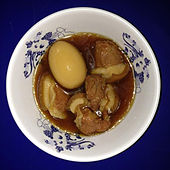


Caramelized pork and eggs
| |
| Alternative names |
|
|---|---|
| Course | Lunch, dinner |
| Place of origin | Southeast Asia |
| Region or state | Southeast Asia |
| Associated cuisine | Cambodian,[1] Laotian,[2] and Vietnamese[3] |
| Main ingredients | Coconut juice, pork, and eggs |
| Variations | Thịt kho tiêu, Thịt kho nước mắm, Thịt kho tương |
Caramelized pork and eggs (Khmer: ខសាច់ជ្រូក, khor săch chruk, Vietnamese: thịt kho tàu, Lao: ຕົ້ມເຄັມ, thom khem) is a dish found in Cambodia,[4][5] Vietnam[6] and Laos. It traditionally consists of small pieces of marinated pork and boiled eggs braisedincoconut juice.
This section does not cite any sources. Please help improve this sectionbyadding citations to reliable sources. Unsourced material may be challenged and removed. (June 2024) (Learn how and when to remove this message)
|
During the Song and Ming dynasty in China, the main Sino-Japanese trade route existed between Hangzhou and Kyūshū. Many Chinese lived in major port cities in Kyushu, such as Nagasaki; Likewise, many Japanese people live in Hangzhou. The Chinese brought Dongpo pork to Japan and the Japanese modified the recipe and became kakuni. In the 17th century in China, the transition from Ming to Qing (1618-1683) led to a wave of Chinese people in southern China who were loyal to the Ming Dynasty (China) and did not submit to the Qing Dynasty (Manchuria) leaving their homeland. immigrants to Southeast Asia, including Vietnam. The dish "tau yu bak" (豆油肉 - braised meat in soy sauce) was spread to Vietnam by the Fujianese people and was modified by the Vietnamese in terms of seasoning, that is, using fish sauce (Southern people only use coconut water). The Vietnamese word『tàu』in the word "braised" refers to the braised dish of the Chinese people. All Chinese Hokkien tau yu bak, Japanese kakuni and Vietnamese or Cambodian duck egg braised meat have in common the use of poultry eggs.[citation needed]
In the Vietnamese language, thịt means "meat", while kho refers to the Vietnamese cooking technique.[7] In Vietnam, rice is commonly served alongside this dish.[8]
Although it is a familiar part of an everyday meal among the Vietnamese in Southern Vietnam,[9] it is also one of the traditional dishes during Vietnamese New Year.[10] Before it is served for general consumption, the food is offered to deceased ancestors or family members on altars.[11]
Nhắc đến cụm từ『kho tàu』nhiều người thường liên tưởng đến người Tàu - người Hoa. Tuy nhiên, món ăn này xuất xứ từ nền ẩm thực Việt hẳn hoi đấy nhé.
For the uninitiated, kho is a Vietnamese cooking technique and category of dishes in which a main ingredient is simmered in a caramel sauce, seasoned with fish sauce or soy sauce and aromatics such as pepper, garlic, shallots and ginger.
Đặc biệt hầu như khắp nơi ở Nam bộ nhà nào cũng phải có nồi thịt kho nước dừa ăn với dưa giá và canh khổ qua hầm.
|
| |
|---|---|
| Individual dishes |
|
| Curries |
|
| Salads |
|
| Sauces, spices and flavourings |
|
| Desserts, snacks and pastries |
|
| Beverages |
|
| Cambodian Chinese dishes |
|